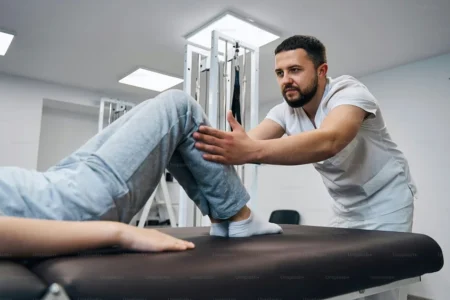If you have back pain and other related symptoms, you can understand how badly it affects the quality of life of a person. It can disrupt your entire life. Spinal decompression therapy – surgical or non-surgical is an option for such people.
Here’s what you should know about non-surgical spinal stenosis therapy to help you decide whether it is right for you.
To know about surgical therapy for spinal stenosis, read this article: Laminectomy Surgery for Spinal Stenosis.
What is nonsurgical spinal decompression therapy?
Non-surgical spinal decompression therapy is a type of motorized traction that can relieve your back pain. Spinal decompression therapy aims to stretch the spine gently, thereby changing the force and position of the spine. This causes a change in the pressure off the spinal disks by creating negative pressure in the disc. As a result, bulging or herniation of the disks may be corrected by taking pressure off the nerves in your spine.
After the pressure on the nerves is taken off, the supply of oxygen and other nutrients also increases to the disks and other structures of the spine allowing them to heal fast.
Theory: How does a spinal decompression therapy work?
Spinal decompression therapy uses the same basic principle of spinal traction that is delivered by healthcare professionals such as chiropractors, osteopaths, etc for a long time. For those seeking chiropractic care, rosenbergwellnesscenter.com is a great place to start. They use the variety of techniques to help reduce tension and inflammation in your spine, which can improve your overall health.
The purpose of therapy is to relieve pain and promote a healing environment for the herniated discs or other conditions that are causing spinal stenosis or any form of nerve compressions such as sciatica.
The spinal decompression aims at:
- Creating a negative intradiscal pressure to promote retraction or repositioning of the disc material
- Creating a lower pressure in the disc to cause an influx of nutrients into the disc
How is spinal decompression done?
During the therapy for the low back (lumbar spine), patients are asked to lie on a motorized table. The lower half of the table is movable. The patient remains clothed during the procedure.
A harness is placed around your hips and is attached to the table near your feet. The upper part of the table remains in a fixed position while the lower part, to which the patient is harnessed, can move back and forth to provide the necessary traction.
You will feel stretch during the procedure in your spine, but it should not be painful. If you experience pain, you should tell the therapist about it.
Spinal decompression therapy cost: Can a spinal decompression therapy be covered under insurance?
Spinal decompression therapy usually includes of a series of 15 to 30 treatments, wherein each such session may last about 30 to 45 minutes. These sessions are delivered for over a four to six-week period.
The cost of each session generally ranges from $30 to $200, which means that the entire series of treatments will cost about $450 to $6,000. While your insurance company might pay for traditional traction, decompression therapy is not usually included in the insurance although they are almost the same.
What are the benefits of nonsurgical spinal decompression? Am I a Candidate for spinal decompression therapy?
Non-surgical spinal decompression is effective in these situations:
- Back pain
- Neck pain
- Sciatica – characterized by pain and weakness, or tingling sensation that extends down the leg
- Bulging or herniated disks
- Other degeneration diseases associated with growing age
- Posterior facet syndrome
- Trauma or other injury to the spinal nerve roots
- Pain in spine due to osteoarthritis
- Abdominal aortic aneurysm
- Advanced osteoporosis
- Metallic implants in the spine
- Spondylitis
- Spinal Infection
- Spondylolisthesis
- Tumors in the spine (bone tumors of the spine)
Other methods of treating spinal stenosis (or other nerve compressions conditions such as sciatica)
- Surgery – Laminectomy
- Nonsteroidal anti-inflammatory drugs (NSAIDs)
- Bracing
- Chiropractic therapy
- Physical therapy
- Rest
- Steroids
- Exercise
- Acupuncture therapy
Research: Safety and effectiveness of non-surgical spinal compression
More research is needed to understand and establish the safety and effectiveness of non-surgical spinal decompression methods.
Only a few small randomized controlled trials and many lower level efficacy studies have been performed on spinal decompression therapy. The quality of these studies is questionable. Many of the studies were performed using the VAX-D® unit which places the patient in a prone position. Often companies utilize this research for their marketing although their units place the patient in the supine position.
There is limited evidence in the scientific data to support the effectiveness of non-surgical spinal decompression therapy. In general, it has not been compared to other non-surgical treatment methods as mentioned above such as exercise, spinal manipulation, acupuncture, or other conservative treatment options.





